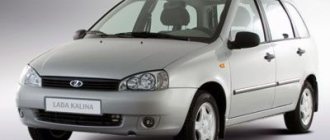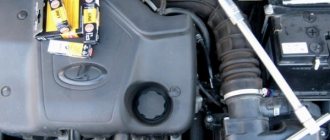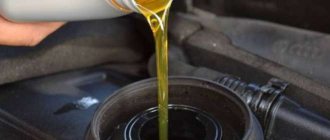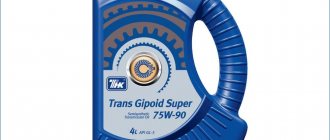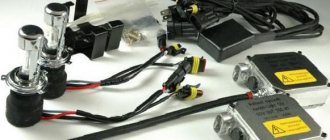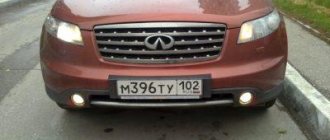It doesn’t matter if the rear wheel on the Kalina doesn’t brake well. But sometimes it's a matter of life and death. If the brakes fail, try pressing the brake pedal a couple more times. If this does not help, then you should use the “engine” brake. There may not be enough time to gradually downshift, so it is worth trying to engage lower gears at once, for example, from 5th to 3rd or from 3rd to 1st.
Author of the article: Yaroslav Alchevsky 08/24/2020 0 0
The domestic auto industry, alas, is not famous for the quality of its cars. When the Lada Kalina wheels do not brake, one or two at a time, the owners try to find a solution. Both front and rear brakes may fail. What to do in this case?
Lada Kalina - main malfunctions and chronic “sores”
Each car has its own pros and cons, strengths and weaknesses. If everyone has their own advantages, then the disadvantages, as a rule, are the same for everyone. Today I will try to highlight the main “diseases” of the people's favorite - Lada Kalina.
This article will be useful for those who are just planning to buy this car and do not know what they should be prepared for. In addition, it will be relevant for “Kalinovods”, who, after reading it, will be able to check this or that unit in advance, thereby preventing a more serious breakdown.
So, in order.
- The thermostat of the Lada Kalina is not famous for its reliability; many people have problems with this. The thermostat often does not work correctly and does not always respond to rising temperatures in a timely manner, resulting in a high risk of engine overheating. The solution to the problem is replacement, and many install “non-native” ones from other models in order to completely eliminate this phenomenon.
- Grenades. CV joints do not last long; around 20-30 thousand, the axle shafts on both sides become unusable. The reason for this phenomenon is that no lubricants are added inside at the factory. The solution to the problem is quite simple - move the boot, check the grease, report if necessary, it is advisable to wash the CV joint and remove the old grease.
- TsBKE, he is like that! Such an expletive as TsBKE can be deciphered by the central unit of body electronics, but it is impossible to understand why it “makes the brains of potassium makers.” This block with a strange name is related to almost all on-board electronics (lights, sensors, tidy, etc.) depending on the state of this block. So, this unit often fails, under absolutely mysterious circumstances, without any reason. After the “death” of this curse, the owner began to “play tricks” with electronics. Something worked and did not stop, but something, on the contrary, refused, in short, extremes.
- Weak grip. One of the weak points was also the clutch; close to 50 thousand, for many it requires replacement. This is despite the fact that on many cars this unit lasts two to three times longer, and for some it lasts almost the entire service life, provided it is used correctly.
- Muffler and catalytic converter. The muffler rots very quickly, at 50-70 thousand km. Most likely you will have to change or cook. The catalytic converter comes off the housing and begins to rattle inside it.
- Ignition coil. Many people started “dancing with a tambourine” because of the reels, when the engine for no reason stopped starting or the traction disappeared, floating idle. After replacing everything possible, people still turned to an electrician, who rendered a verdict that the coil was faulty.
- Little things. Rattling windows, it’s unclear how the power windows (as well as their buttons) work, glitchy multimedia, etc.
- Spider bugs. Despite the fact that corrosion protection on the new Kalinas has improved, the appearance of small pockets of corrosion can still be observed. Quite quickly, so-called bugs appear in the area of thresholds, on doors and other places that are exposed to moisture.
Despite the accessibility and maintainability of such popular “bestsellers” as the Lada Kalina, there are fewer and fewer people who want to constantly drive something somewhere. People prefer more reliable foreign analogues. This is not surprising, given the fact that these “sores” from generation to generation in Lada, unfortunately, are not getting smaller. Perhaps if the manufacturer listened to the consumer, correcting known errors and breakdowns, I am already silent about recall campaigns, as is customary in the West, then perhaps there would be much more admirers of the domestic automobile industry.
Lada Kalina - first impressions
While my impressions are fresh, I’ll share them. I drove a VAZ-21099 (1997) for two years. I had an imported version, which was produced in Finland (distinctive features from the Soviet standard - a different dashboard, made of higher quality plastic and a different shape + factory air conditioning + bumpers were painted in body color and slightly modified). At the time of sale the car was already 15 years old. By and large, there were no particular complaints - the machine served well, but, alas, the years take their toll. Therefore, it was decided to sell the car, since it was in fairly reasonable condition, and buy something newer.
Since the budget was small (about $7,500), there wasn’t much choice (the task was to buy a car no older than 5 years, with a mileage of about 50,000 km, and always with air conditioning).
Daewoo was rejected immediately due to the cramped interior. Although, the machine itself is quite reliable. Unfortunately, finding something else from imported cars to meet the requirements described above turned out to be an impossible task. Therefore, the choice was made on “Kalina”. Here, as if on purpose, a completely suitable option turned up:
- Kalina Universal (VAZ-1117) 2009;
- Mileage – 59500 km;
- Volume 1.4;
- Air conditioning, ABS.
The car turned out to be in very good technical condition - the owner spared no expense. During operation the following were replaced:
- front pillars;
- timing belt;
- clutch with release bearing;
- fog lights installed;
- imported oil has been poured into the gearbox;
- in the engine - Castrol Magnatec.
What immediately attracted attention after the first trip behind the wheel of Kalina (in comparison with 21099):
- The high seating position of the car, which was noticed at the traffic police post (they did not fail to brake when they saw the red license plates) - the inspector’s question: Is it all-wheel drive? (turn out the light). As it turned out later, such a high landing of the car was achieved thanks to duralumin spacers between the front pillars and glasses. I had to remove them because they caused unnecessary deformation on the glasses, which are already “famous” for one of Kalin’s weak points. However, even after this the car has a rather high seating position;
- Better visibility, both forward and backward (the side mirrors will be larger than on the 99);
- Very tenacious brakes - if you press too hard, the car stops dead in its tracks;
- The steering is very light at low speeds, but very stiff at speeds over 60 km/h. What they say about the “uninformative steering” remains a mystery to me. I repeat – the steering wheel on Kalina is the most “normal” – you turn it to the left and the car turns left; turn to the right - turns to the right; don't turn it - the car goes straight;
- It’s just a huge interior compared to the 99, although you can’t tell from the outside - there’s a lot of headroom for both front and rear passengers; There is also quite a lot of legroom - you can waddle quite comfortably. Of course, three healthy men will be cramped in the back seat, but two adults and one child, or three medium-sized adults, will be quite comfortable during a long trip;
- Night lighting of the dashboard is two orders of magnitude better + very good high beam, since both low and high beams work;
- Excellent suspension that absorbs all the bumps and unevenness of the road without any problems.
Kalina's problems that were immediately discovered:
- Weak design of the front glasses (cups) on which the front pillars are attached. It is treated by installing amplifiers made of metal with a thickness of 3-3.5 mm;
- Difficulty engaging first gear while driving (when the car is slightly rolling)
Time will tell how trouble-free the car will be in operation. But so far the impressions are positive.
Top of page
Frequent faults and weaknesses of LADA Kalina
LADA Kalina has become a truly people's car, but not because of its technical characteristics, quality or convenience. Its popularity is based on its low price. Those who do not have enough money for a foreign car, or those who are afraid to buy a higher-class used car, decide to purchase Kalina.
Car production began in 2004. Since then, the model range has been constantly modernized, the technical components have been improved, and new “chips” have been added for convenience, savings and improvement of various indicators. Depending on the configuration, the 1st generation Kalina was equipped with:
- 8- and 16-valve engines with a volume of 1.4 or 1.6 liters;
- anti-lock brake system;
- two airbags;
- air conditioning;
- electric power steering;
- standard audio system;
- and even an electronic gas pedal.
The first generation of Kalina was produced in three body types: sedan, hatchback and station wagon. In 2008, the Sport version was released. Production ceased completely in 2013, when all conveyors were converted to the second generation.
The disadvantages of the 1st generation LADA Kalina regarding the body, chassis and main components are well known to car owners. There are several known cases when AvtoVAZ recalled produced cars due to identified defects: steering gear housing, engine mounts and others. However, most of the shortcomings fall on car owners. Some put up with them, some try to use ingenuity to correct the developers' shortcomings.
How does the Lada Kalina brake system work?
The Lada Kalina brake system has two working circuits, which are located diagonally. The left front wheel brakes work together with the right rear wheel, and the right front wheel works with the left rear wheel. The brake system consists of different elements that periodically fail. These include:
- vacuum brake booster (VUT) - needed to create additional force;
- master brake cylinder (MBC) – to create pressure in the hydraulic drive;
- hydraulic reservoir (needed to replenish brake fluid);
- front wheel brake system (disc, 2 brake pads, which are compressed by a single-piston mechanism);
- pressure regulator (popularly called simply “sorcerer”);
- rear wheel braking system (drum type device with a two-piston wheel cylinder and automatic clearance adjustment).
Brake system "Lada Kalina"
The design of the front and rear brakes is fundamentally different. The operation of the front disc brakes is more stable. Most often, the rear wheels on the Kalina do not brake.
Weaknesses of LADA Kalina 2004–2013 release
- Gear box;
- Brake system;
- Electrical;
- Cooling system;
- Chassis.
Gear box
The Kalina gearbox, both in terms of assembly and the materials used, leaves much to be desired. According to statistics from large service stations, drivers often complain about reverse gear, which refuses to engage due to a damaged protection wire, as well as about problematic second gear.
The clutch disc also fails quite quickly. Many people still complain about extraneous noise from the clutch, even on cars that have just come off the production line. This is usually solved by replacing the gearbox oil with a higher quality one.
It is also often necessary to change brake discs, which may develop grooves or uneven wear even after 10 thousand km. The reason for this is most often the pads - poor quality or worn out. Dirt, which is not retained by the anthers, also plays a big role.
The problem can strike at the most inopportune moment. The most common complaints are the failure of the horn, power windows, and forced cooling. There are problems with headlights: frequently burning out bulbs or loose wire contacts.
Drivers may be facing repairs due to loose clamps and cracked pipes. This leads to a coolant leak or a leak in the heater radiator. The pump and engine temperature sensors often fail.
The Kalina's chassis is still not designed for heavy loads, and after several large potholes it can make itself felt. The shock absorbers, especially the rear ones, do not cope very well with the unevenness of Russian roads.
Disadvantages of LADA Kalina 1st generation
- The main drawback is the build quality. Both the human factor and the low quality of the materials used play a big role;
- Sound insulation is quite poor. Over time, extraneous noise appears. Therefore, it is desirable to treat the entire interior, engine compartment, and trunk;
- Locks are also a common problem, especially on the rear doors. The result is difficult opening, even torn off handles. It is safe to say that they will have to be regulated in the near future;
- Despite the fact that the car was developed for Russia, it does not withstand the cold without problems. There are headlights or washer pipes cracked in the cold. The seals of doors and windows may crack, which leads to disruption of sound insulation and extraneous noise;
- Rust is also the scourge of domestic cars. On Kalina, it first of all affects the muffler, which still burns out quite quickly. Of course, Kalina has gone far ahead of her older brothers. The concern uses galvanized metal and new painting technologies. But still, experienced craftsmen advise not to neglect anti-corrosion treatment, especially on the bottom, sills and chipped areas.
How to stop a car if the brakes fail
It doesn’t matter if the rear wheel on the Kalina doesn’t brake well. But sometimes it's a matter of life and death. If the brakes fail, try pressing the brake pedal a couple more times. If this does not help, then you should use the “engine” brake. There may not be enough time to gradually downshift, so it is worth trying to engage lower gears at once, for example, from 5th to 3rd or from 3rd to 1st.
It also makes sense to try using the parking brake. You cannot jerk the handbrake sharply, you need to brake carefully. If in winter one wheel slows down better than the other, by pulling the handbrake you can fly into a ditch or turn the car 180 or even 360 degrees.
Lada Kalina after 75,000 km: typical and specific faults
It’s not always possible to come up with a successful nickname for a car, but the nickname Borsch stuck to the editorial Kalina for life. Moreover, everyone who is familiar with the car only calls it this: what, they say, Borscht? Did you fix the borscht?
The analogy is quite simple. The colors of our Kalina and borscht do not exactly match, but both are quite simple, inexpensive and at the same time satisfying product. And for combining everyday use with year-round participation in amateur competitions, Kalina is one of the most successful options.
Manufacturer - AVTOVAZ Year of manufacture - 2013 In operation "Behind the wheel" - since September 2013 Mileage at the time of report - 75,000 km
The engine is still running without serious complaints: it doesn’t make noise, it doesn’t consume oil. Suspicions of a slight loss of dynamics began to arise, but they disappeared when Borsch unexpectedly improved his time on a practiced track. However, recently the idle speed on a warm engine has begun to fluctuate noticeably. Moreover, it starts unexpectedly and out of the blue, and after a short time it goes away on its own. In this case, the error code does not appear, and everything is clear in the control unit’s memory. At first I was guilty of air leaks at the inlet, but everything turned out to be sealed - I'll have to wait for a more obvious manifestation of the disease.
The gearbox feels normal, but in any temperature conditions it continues to make a distinct noise in “neutral” with the clutch released. Although, when we repaired it at 50,000 km due to burnt second gear synchronizer rings, troubleshooting did not reveal any other faulty parts. The practice of specialized service stations shows that it is extremely difficult to overcome the specified specific noise of such boxes.
In the steering, the steering tips had to be renewed again, in which play appeared after the next 20,000 km. These were, although not original, still proven parts from a respected brand. Most likely, one of the winter tracks with a very harsh surface, along which Kalina and I drove in combat mode, backfired.
To be fair, I note that on the Kalinas of other racing participants, the original tips have to be changed at approximately the same frequency.
At 75,000 km I updated the shock absorbers all around. The factory gas struts served faithfully, and many would say that it can still be driven. But the struts significantly lost their rigidity - this was clearly felt on the track and when checking the removed shock absorber (when you push the rod in and out). I purchased original parts for replacement.
Is it possible to drive a car with non-working brakes?
No matter how much power is under the hood, no matter how expensive the wheels on a car are, the most important thing in a car is the steering and brakes. You need to be able to stop in time and get out of the situation in time.
The legislation contains Article 12.5 of the Code of Administrative Offenses of the Russian Federation, which provides for the detention of a car for a faulty brake system. That is, if you get caught by the police, the car will be taken to the impound lot, and the driver will also receive a fine of 500 rubles. But there is one caveat - this article does not apply to handbrake malfunctions.
In any case, serviceable brakes mean the safety of you and other road users, so if the slightest sign of a malfunction appears in this system, you should immediately take repair measures.
Lada Kalina - main malfunctions and chronic “sores”
Each car has its own pros and cons, strengths and weaknesses. If everyone has their own advantages, then the disadvantages, as a rule, are the same for everyone. Today I will try to highlight the main “diseases” of the people's favorite - Lada Kalina.
This article will be useful for those who are just planning to buy this car and do not know what they should be prepared for. In addition, it will be relevant for “Kalinovods”, who, after reading it, will be able to check this or that unit in advance, thereby preventing a more serious breakdown.
So, in order.
- The thermostat of the Lada Kalina is not famous for its reliability; many people have problems with this. The thermostat often does not work correctly and does not always respond to rising temperatures in a timely manner, resulting in a high risk of engine overheating. The solution to the problem is replacement, and many install “non-native” ones from other models in order to completely eliminate this phenomenon.
- Grenades. CV joints do not last long; around 20-30 thousand, the axle shafts on both sides become unusable. The reason for this phenomenon is that no lubricants are added inside at the factory. The solution to the problem is quite simple - move the boot, check the grease, report if necessary, it is advisable to wash the CV joint and remove the old grease.
- TsBKE, he is like that! Such an expletive as TsBKE can be deciphered by the central unit of body electronics, but it is impossible to understand why it “makes the brains of potassium makers.” This block with a strange name is related to almost all on-board electronics (lights, sensors, tidy, etc.) depending on the state of this block. So, this unit often fails, under absolutely mysterious circumstances, without any reason. After the “death” of this curse, the owner began to “play tricks” with electronics. Something worked and did not stop, but something, on the contrary, refused, in short, extremes.
- Weak grip. One of the weak points was also the clutch; close to 50 thousand, for many it requires replacement. This is despite the fact that on many cars this unit lasts two to three times longer, and for some it lasts almost the entire service life, provided it is used correctly.
- Muffler and catalytic converter. The muffler rots very quickly, at 50-70 thousand km. Most likely you will have to change or cook. The catalytic converter comes off the housing and begins to rattle inside it.
- Ignition coil. Many people started “dancing with a tambourine” because of the reels, when the engine for no reason stopped starting or the traction disappeared, floating idle. After replacing everything possible, people still turned to an electrician, who rendered a verdict that the coil was faulty.
- Little things. Rattling windows, it’s unclear how the power windows (as well as their buttons) work, glitchy multimedia, etc.
- Spider bugs. Despite the fact that corrosion protection on the new Kalinas has improved, the appearance of small pockets of corrosion can still be observed. Quite quickly, so-called bugs appear in the area of thresholds, on doors and other places that are exposed to moisture.
Despite the accessibility and maintainability of such popular “bestsellers” as the Lada Kalina, there are fewer and fewer people who want to constantly drive something somewhere. People prefer more reliable foreign analogues. This is not surprising, given the fact that these “sores” from generation to generation in Lada, unfortunately, are not getting smaller. Perhaps if the manufacturer listened to the consumer, correcting known errors and breakdowns, I am already silent about recall campaigns, as is customary in the West, then perhaps there would be much more admirers of the domestic automobile industry.
Lada Kalina 1 repair: the most common car breakdowns
The first generation of Lada Kalina cars was produced in Russia from 2004 to 2013. Over 9 years of production, a simple car with a five-speed manual transmission and a gasoline engine managed to take a leading position in the domestic equipment market. Thousands of sedans, station wagons and hatchbacks of this model still roam the expanses of our homeland. Despite its popularity among the population, Lada Kalina 1 is far from an ideal car, having a number of specific features and typical problems.
The weakest points of this technique are:
- clutch (problems with it begin after 50 thousand kilometers; the clutch disc breaks first);
- engine (in order for it to be in good condition, it is necessary to monitor the amount of oil in the system, since there is no oil level indicator arrow on the dashboard);
- external constant velocity joints were poorly lubricated at the factory and therefore quickly began to make unpleasant sounds, often ending in premature failure of the part;
- noisy gearbox, which is not made quieter even by high-quality gear oil and new bearings;
- a water pump that tends to jam and causes problems with the timing belt;
- an engine thermostat, often supplied with a faulty valve, which can lead to overheating or underheating of the engine;
- a generator that has problems with the diode bridge and bearings;
- timing belt, which can break and lead to unpleasant consequences in the form of deformed valves.

